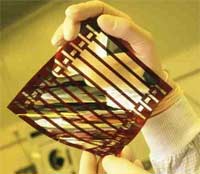Researchers in the United States and Austria report an advance toward the next generation of plastic solar cells, which are widely heralded as a low cost, environmentally-friendly alternative to inorganic solar cells for meeting rising energy demands.
Alan J. Heeger and colleagues point out that plastic solar cells, fabricated from bulk heterojunction materials comprising semiconducting polymers and fullerenes, have already demonstrated promising performance.
However, researchers do not understand how to control the nano-scale morphology and are looking for ways to optimize the solar cell performance for practical use. Heeger, co-recipient of the Nobel Prize in Chemistry in 2000 for his pioneering research on conducting polymers, is widely recognized for his ongoing efforts to improve solar cell efficiencies.
In the new study, Heeger and colleagues found that adding a class of chemicals called alkanedithiols as processing additives improves both the morphology and the solar cell performance.
They showed that by utilizing alkanedithiols as processing additives, the efficiency of the plastic solar cells increased from 3.4 percent to 5.1 percent, among the highest efficiencies achieved to date for this type of solar cell.
"These data provide a better understanding of correlation between the nano-scale morphology of the bulk heterojunction film and the solar cell performance," the report states."

